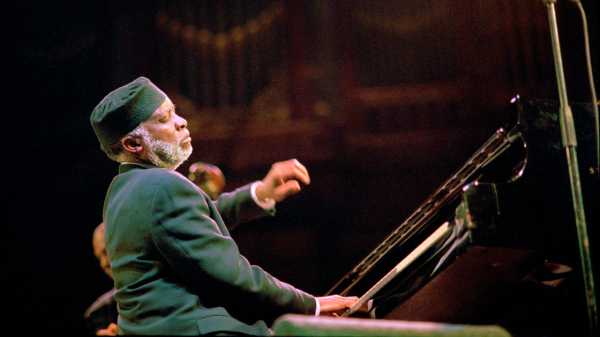
The musician Ahmad Jamal, who died on Sunday at the age of ninety-two, was a modest colossus of jazz who subtly cast his musical imagination across a wide spectrum of forms and ideas. What’s more, he did so precociously, making his first, and strongly influential, recordings in 1951 and 1952, in his early twenties. He was an ingenious improviser, as sophisticated and audacious in his musical choices as were the bebop pioneers who were his contemporaries. He conceived his improvisations as journeys through musical landscapes, and, like a modern painter, he understood the power of blank spaces: he was as eloquent with dramatic silences and suspended phrases as in torrential outpourings of sound. Jamal was an arranger of genius, who took both familiar and unfamiliar tunes from the Great American Songbook and transfigured them, finding latent patterns or reshaping them with new ones. He was a visionary orchestrator, inasmuch as he reimagined his small groups—mainly trios for piano, bass, and drums—contrapuntally; he approached his performances with them as if he had a big band at his command.
Jamal was a virtuoso who often played epigrammatically (making his florid punctuations and whirlwind outbursts all the more thrilling). He was an audacious musical inventor who channelled his concepts into a deceptively conventional format—centered on pop tunes played melodically—that gave rise to critical misunderstandings. Moreover, he had the good fortune and the sure judgment to achieve an unusually substantial commercial popularity by way of his uncompromising and independent-minded music-making, and the bad fortune that his popularity sometimes stood in the way of his artistic recognition. Though his style is inimitable, his ideas strongly took root and had a decisive effect on the history of jazz, even before he himself became celebrated. In the mid-nineteen-fifties, when Miles Davis was forming a new style and a new band, he was crucially influenced by Jamal’s early recordings. Davis’s new quintet, featuring John Coltrane, recorded Jamal’s composition “Ahmad’s Blues” in addition to songs that appeared on Jamal’s early records; Davis’s own style of improvisation underwent a shift, toward the use of silences and the power of precisely placed single notes or short phrases, that held throughout the rest of his career and was at the core of his celebrated manner. By the time that Jamal had unleashed his first set of definitive classic recordings, his musical DNA was already at the forefront of the art, an engine of the music’s modernity.
Born Frederick Russell Jones, in Pittsburgh, in 1930, Jamal was a piano prodigy, playing, he said, “orchestrally almost” at the age of five and memorizing, in early childhood, a vast quantity of Broadway and movie songs. He had many years of formal piano study; at the age of eleven, he was the pianist in a high-school big band. He intended to go to Juilliard, but instead, at seventeen, he was hired to go on the road with a major regional jazz band. He moved to Chicago at the turn of the nineteen-fifties and took the name Ahmad Jamal when he converted to Islam. After several years of wide-ranging gigging in a variety of groups and settings, he became a leader, at twenty, of a trio called the Three Strings (joined by bass and guitar). His musical vision was already sharp, precise, and confident; he was working with the bassist Israel Crosby and the guitarist Ray Crawford when, in 1955 or 1956, after an incident in a New York club (a patron spilled red wine on his keyboard), he and Crosby indignantly returned to Chicago. There, Jamal quickly fulfilled his intention to replace the guitar with drums, and soon hired the drummer he’d long had in mind, Vernel Fournier. That trio made history, and it did so in large measure because of Jamal’s expansion of his role as pianist and leader to become something like a director, an auteur of his own art, with a unique and personal method of production.
First, Jamal got the trio installed in an extended residency at a Chicago club called the Pershing Lounge, and he made use of their ongoing public performances both to hone their material and to note what went over with the audience. Then he persuaded a sympathetic and ambitious record-company owner, Leonard Chess, to record the group—at the Pershing, live, with remote equipment. Moreover, Jamal himself produced the recording sessions at the club, choosing the repertory himself—notably, an extended version of the ballad “Poinciana,” which he’d recorded altogether differently in 1955, and for which he, Crosby, and Fournier worked out an elaborate, fixed, hypnotically alluring rhythmic pattern, one that seemed to spin variations out beyond the horizon of its musical landscape. Jamal was sure that he had an impending hit on his hands, and he was right. (Once the arrangement was worked out, he stopped playing it publicly, fearing that another musician would steal it.) The single charted, and the album, “But Not for Me,” spent two years on the charts and brought him both money and acclaim. (Interviewed recently, Jamal said, “It’s been the thing that has paid the bills for the last 61 years.”)
Some critics derided Jamal as a “cocktail” pianist, someone whose melodic approach to pop tunes served as a pleasantly unobtrusive background for bar conversation. The invective was likely also fuelled by the essentially joyful essence of Jamal’s music—no naïve cheer but an exuberant expression of the power of his imagination, of beauty, and of music itself. The joy of Jamal’s work reflected the light of community and family. Pittsburgh was a central city for music, the home town of such luminaries as Erroll Garner, Billy Strayhorn, Art Blakey, and Stanley and Tommy Turrentine; Jamal was encouraged and musically nourished by the community and by his family life. But his popularity counted against him and obscured his actual profundity. One critic who scathingly repudiated Jamal’s music in 1958, The New Yorker’s jazz writer Whitney Balliett, did so not on the grounds of the pianist’s charm but of his idiosyncratic modernism, grousing that Jamal’s dramatic punctuations of his music with silences “eventually gives the impression achieved by spasmodically stopping and unstopping the ears in a noisy room.”
Jamal continued to pursue his path of musical and practical independence, following up, through 1962, with bold and delightful live recordings from clubs in Washington, D.C., San Francisco, and a club he owned in Chicago, called the Alhambra. (The boxed set “The Complete Ahmad Jamal Trio: Argo Sessions 1956-62” features these concert performances and his handful of studio recordings in that period; it’s one of the centerpieces of recorded music, as I wrote when it came out, in 2010. It’s also a key source of information about Jamal, because its booklet featured an extensive and insightful interview with him, by the drummer Kenny Washington.)
Tired of the touring life, Jamal sought to create a home base in Chicago, and the success of his earlier album financially enabled him to do so. But the administration of the Alhambra was a burdensome distraction from music, and the club wasn’t financially successful. (He blamed it on the fact that it sold no alcohol, consistent with his faith.) He lost the club, went through a divorce, and had other financial reversals. Amid his personal difficulties, his music, too, reflected turmoil. During the sixties, his improvisations expressed an urge to expand beyond the confines of his group’s meticulous arrangements. He disbanded the trio and, with new personnel in the next few years, moved in a newly expansive direction that came to fruition in a different trio, in 1966, with the bassist Jamil Nasser and the drummer Frank Gant; it had a looser, wilder, more impulsive bent and propelled Jamal to longer, bolder expatiations, often with complex original compositions in lieu of Broadway or Hollywood standards. Without losing his exuberance, Jamal became more intense, sharper-edged. With this group, he established the style and the form that would hold for the rest of his career.
That was where I came in, as a teen-ager, around 1974, when I heard this group’s nearly sixteen-minute-long romp through Richard Evans’s composition “Bogota,” live in 1971, from an album called “Outertimeinnerspace” that featured Jamal on both piano and electric piano. It was an advantage to discover the nineteen-fifties recordings only subsequently; I felt the continuities in the change, understood them to be conceptually organic, and saw the principle of expansion lurking within the earlier classics. However turbulent his music became, it retained an essential serenity, reflecting the great stream of musical and cultural traditions that nurtured and sustained him. But Jamal, having already made musical history, was nonetheless subject to its winds. Over the years, he had intermittently recorded in a variety of formats, as with an orchestra, a string orchestra, and a vocal ensemble. With the commercial popularity of jazz dwindling and jazz-rock fusion coming to the fore, Jamal made a series of overproduced albums in which his own playing was undiminished but also relatively unstimulated. The eighties brought a sort of jazz classicism to the fore, and in his fifties Jamal both made a spate of new recordings and found a new prominence in France, where he made many of his recordings from the nineties onward. (He’s in ebullient form on the 2001 album “À L’Olympia,” and he fuses melodies and arrangements to splendid effect in two of his recent works, “It’s Magic” and “Marseille.”) Jamal’s wisdom and inspiration—and the sheer force of his deep-rooted exploration and embodiment of musical history—shone through as mightily in his later years as at the start. ♦
Sourse: newyorker.com






